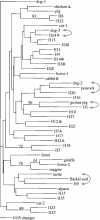Genetic relationship between human and animal isolates of Candida albicans
- PMID: 16333121
- PMCID: PMC1317197
- DOI: 10.1128/JCM.43.12.6164-6166.2005
Genetic relationship between human and animal isolates of Candida albicans
Abstract
Analyzing Candida albicans isolates from different human and animal individuals by Ca3 fingerprinting, we obtained no evidence for host-specific genotypes and for the existence of species-specific lineages, even though a certain degree of separation between human and animal isolates was found. Therefore, animals could potentially serve as reservoirs for human Candida infection.
Figures


References
-
- Bougnoux, M.-E., D. M. Aanensen, S. Morand, M. Théraud, B. G. Spratt, and C. d'Enfert. 2004. Multilocus sequence typing of Candida albicans: strategies, data exchange and applications. Infect. Genet. Evol. 4:243-252. - PubMed
-
- Clark, P. J., and F. C. Evans. 1954. Distance to nearest neighbor as a measure of spatial relationships in populations. Ecology 35:445-453.
-
- Edelmann, A., and J. Bär. 2002. Molecular genetics of 6-phosphofructokinase in Pichia pastoris. Yeast 19:949-956. - PubMed
-
- Hörmansdorfer, S., and J. Bauer. 2000. Yeast infection in veterinary medicine. Contrib. Microbiol. 5:54-78. - PubMed
-
- Hube, B. 2004. From commensal to pathogen: stage- and tissue-specific gene expression of Candida albicans. Curr. Opin. Microbiol. 7:336-341. - PubMed
MeSH terms
Substances
LinkOut - more resources
Full Text Sources
Miscellaneous

